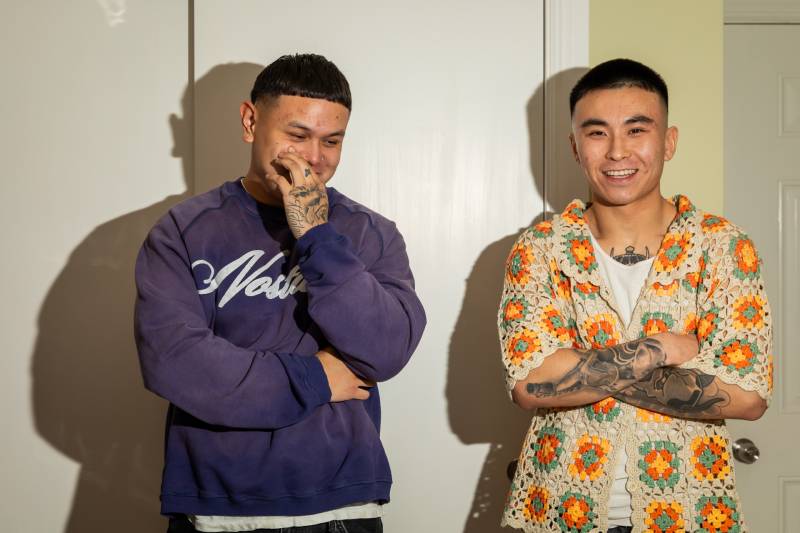Monologika - Yoyo 1.,2. (U.F.O.)
1982 - Photography (Photography)
8,1 x 11,6 x 2 cm
Julius Koller
The photograph Monologic – Yo-Yo 1, 2 (U. F. O.), (1982), shows Koller playing with a big white Yo-Yo in a drab concrete building among a group of tower blocks. For him, games like ping-pong or the yo-yo representsed the possibility of a more playful society in the face of socialist standardization. Koller’s semiological manipulations of landscape and topography, of places and (his own) faces, investigate the possibilities of shifting meaning by the simplest alterations. In deadpan-humorist fashion, most poignantly displayed in a series of photo-portraits that cover a period of more than four decades, he systematically explores the relationship between art and alienation, or the idea of art as alienation. “U. F. O.-naut J. K.” becomes the artist’s altered ego, an extraterrestrial maker and distributor of universal signs: question marks, Ping-Pong balls, or wave lines, a more recent signature symbol, formed by tennis balls in a swimming pool in 1992 or drawn on the floor in the “antiperformance” Nova vaznost’, 1991.” (Tom Holert, Artforum, October, 2004).
In its stringency, obsession and peculiarity, the oeuvre of Julius Koller is one of the most idiosyncratic and consistent in European art since the 1960s. Yet Koller is not only a seminal figure in the history of the neo- and post-avant-garde; his work has long been a critical inspiration for artists and intellectuals. In the most recent past, Koller’s concepts of the Anti-Happening, the Anti-Picture, the Universal-cultural Futurological Operation (U.F.O.), his actions, objects, texts and the enormous referential archive he built up, have attracted growing interest on the part of a broader art public. From around 1960, in response to the modernist mainstream in Slovak art, Julius Koller began to develop his aesthetic position of the “antihappening.” His strategy consists in using real objects and everyday life as the predefined program for an aesthetic operation: from 1965, in texts rubberstamped on paper that refer to the context of the “anti-happening,” and then in 1967/1968 in pictures for which Koller used white latex paint instead of oils and which saw the first appearance of the question mark—the symbol of Koller’s brands of naming, or “making known,” that was later to undergo many mutations in various media and states of aggregation. The “invitation cards for an idea”—as Koller called the text works relating to the “anti-happenings”—and the palimpsests and serial arrangements of the “anti-pictures” set themselves apart from the academicism of Modernism in more than just formal terms. Koller foregoes every form of technical mastery. The “anti-pictures” are amateurish in style, ensuring that they fulfill their task, defined by Koller as “engaging rather than arranging.” Julius Koller was born in 1939 in Piestany, Slovakia. He died in 2007 in Bratislava.
Colors:
Related works featuring themes of: » Performance Art, » Slovakian
» see more

© » KADIST
Roman Ondak
2003As the caption purposely admits, these drawings were made by friends of Ondák’s at home in Slovakia asked to interpret places he has journeyed to...

© » KADIST
Paul McCarthy
2010To make Mickey Mouse (2010), Paul McCarthy altered a found photograph—not of the iconic cartoon, but of a man costumed as Mickey...
Other related works, blended automatically
» see more

© » KADIST
Roman Ondak
2003As the caption purposely admits, these drawings were made by friends of Ondák’s at home in Slovakia asked to interpret places he has journeyed to...
© » KADIST
Rabih Mroué
2012The Pixelated Revolution is a lecture-performance by artist Rabih Mroué about the use of mobile phones during the Syrian revolution...
Related works sharing similar palette
» see more

© » KADIST
Abraham Oghobase
2018This series of photographs is inspired by the artist’s travels to Jos, Nigeria...

© » SLASH PARIS
ALICEGAVINSERVICES™ — La MABA — Exposition — Slash Paris Connexion Newsletter Twitter Facebook ALICEGAVINSERVICES™ — La MABA — Exposition — Slash Paris Français English Accueil Événements Artistes Lieux Magazine Vidéos Retour ALICEGAVINSERVICES™ Exposition Design, graphisme, techniques mixtes Derniers Jours Alice Gavin, ALICEGAVINSERVICES™, sans titre Crédit photo : Léonard Méchineau ALICEGAVINSERVICES™ Encore 6 jours : 14 septembre → 17 décembre 2023 Cet automne, dans le cadre de sa saison dédiée au design graphique, la MABA présente, du 14 septembre au 17 décembre, une exposition consacrée à ALICEGAVINSERVICES™...

© » ARTS EQUATOR
AE x Goethe-Institut Critical Writing Micro-Residency: Meet the Writers (Part 2) | ArtsEquator Thinking and Talking about Arts and Culture in Southeast Asia ArtsEquator Viewpoints May 28, 2021 We recently announced our selected resident writers for the inaugural AE x Goethe-Institut Critical Writing Micro-Residency, focusing on the development and promotion of critical writing about arts and culture in Southeast Asia...

© » KADIST
Siavash Naghshbandi
2019Daily Life of Human is comprised of a fast-paced series of still images selected by the artist from ImageNet, a massive dataset of images (about 14 million) produced by BigGAN...
Other works by: » Julius Koller
» see more

© » KADIST
Julius Koller
Anti-Happening refers to Koller’s 1965 manifesto, ‘Anti-Happening (System of Subjective Objectivity)’...
Related artist(s) to: Julius Koller » Rirkrit Tiravanija, » Mladen Stilinović, » Anton Vidokle, » Douglas Gordon, » Roman Ondák, » Deimantas Narkevičius, » Hans Ulrich Obrist, » Jiří Kovanda, » Mona Hatoum, » Rasha Salti
» see more

© » KADIST
Anton Vidokle
2020Shot in Oliveto Lucano, a village in the south of Italy, AUTOTROFIA (meaning self-eating) by artist Anton Vidokle is a cinéma vérité style film that slides fictive characters into real situations, and vice-versa, to draw a prolonged meditation on the cycle of life, seasonal renewal, and ecological awareness...

© » KADIST
Douglas Gordon
1996In Monster (1996-97), the artist’s face becomes grotesque through the application of strips of transparent adhesive tape, typical of Gordon’s performance-based films that often depict his own body in action...

© » KADIST
Mladen Stilinovic
1985The Exploitation of the Dead cycle is composed of a very large number of elements which the artist reorganizes differently every time...

© » KADIST
Jiri Kovanda
1992Untitled (1992) responds to the same principles of an economy of means as the artist’s actions and installations: three empty cardboard boxes which have contained photographic film are piled one on top of the other...
Related works found in the same semantic group
» see more

© » KQED
This Bay Area Filipino Streetwear Is a Favorite Among Rappers and Rebels | KQED Skip to Nav Skip to Main Skip to Footer Arts & Culture This Bay Area Filipino Streetwear Is a Favorite Among Rappers and Rebels Dario McCarty Dec 13 Save Article Save Article Failed to save article Please try again Facebook Share-FB Twitter Share-Twitter Email Share-Email Copy Link Copy Link Jaden Yo-Eco (left) and Humbert Lee pose for a portrait at Lee’s home in Daly City on Nov...

© » SLASH PARIS
Resilient Currents: On Communal Re-Existence — Forma — Exhibition — Slash Paris Login Newsletter Twitter Facebook Resilient Currents: On Communal Re-Existence — Forma — Exhibition — Slash Paris English Français Home Events Artists Venues Magazine Videos Back Previous Next Resilient Currents: On Communal Re-Existence Exhibition Mixed media Upcoming Seba Calfuqueo, Miroir d’eau (capture d’écran), 2023 Courtesy de l’artiste Resilient Currents: On Communal Re-Existence In about 1 month: March 21 → April 25, 2024 In anticipation of La Collective, its future creation and solidarity center, Thanks for Nothing presents its first international exhibition, which focuses on socially engaged practices related to Central and South America...







